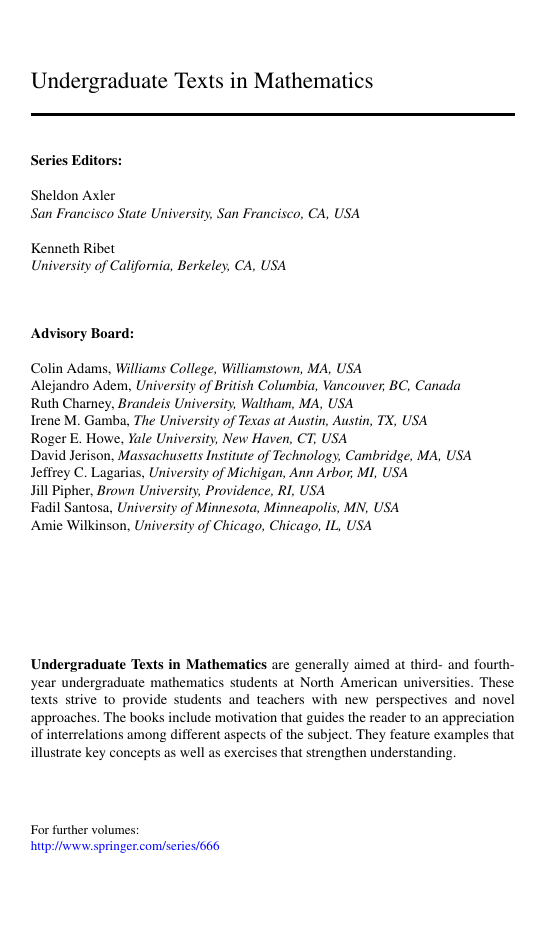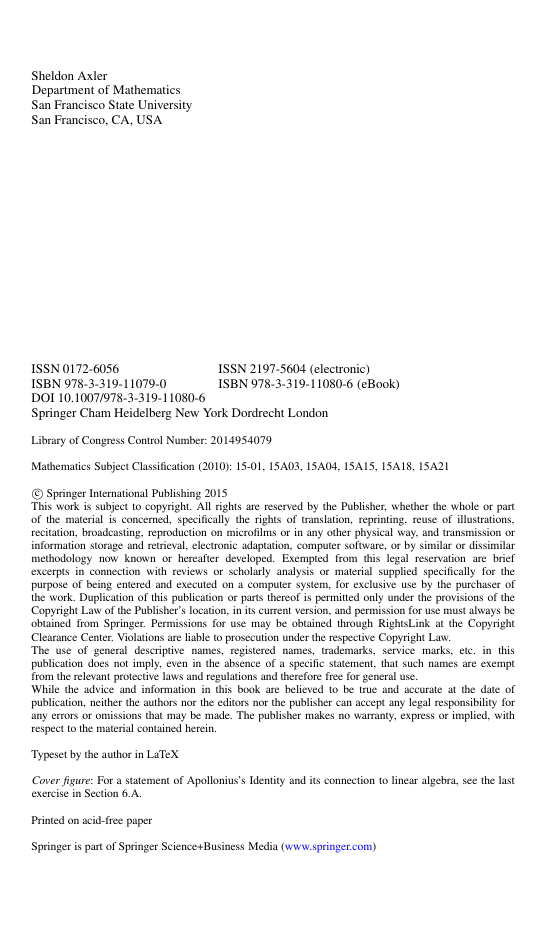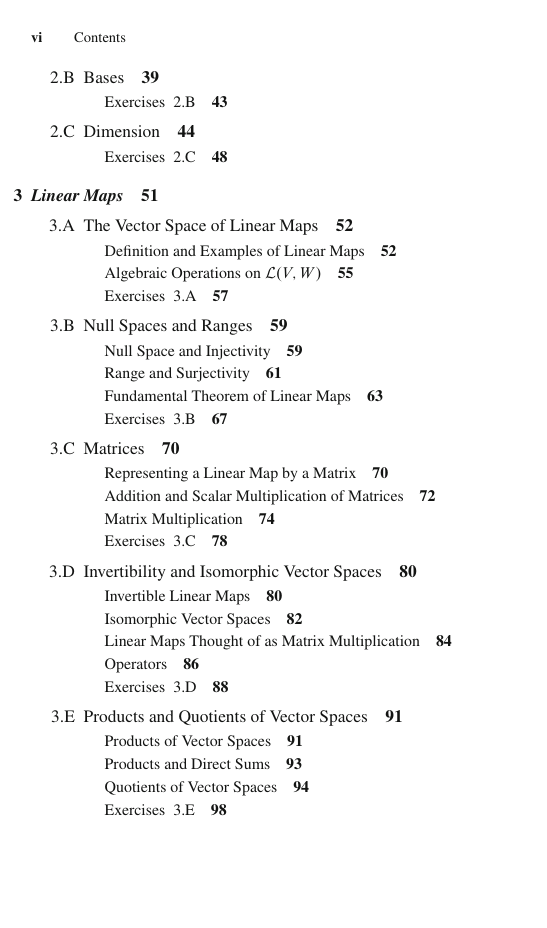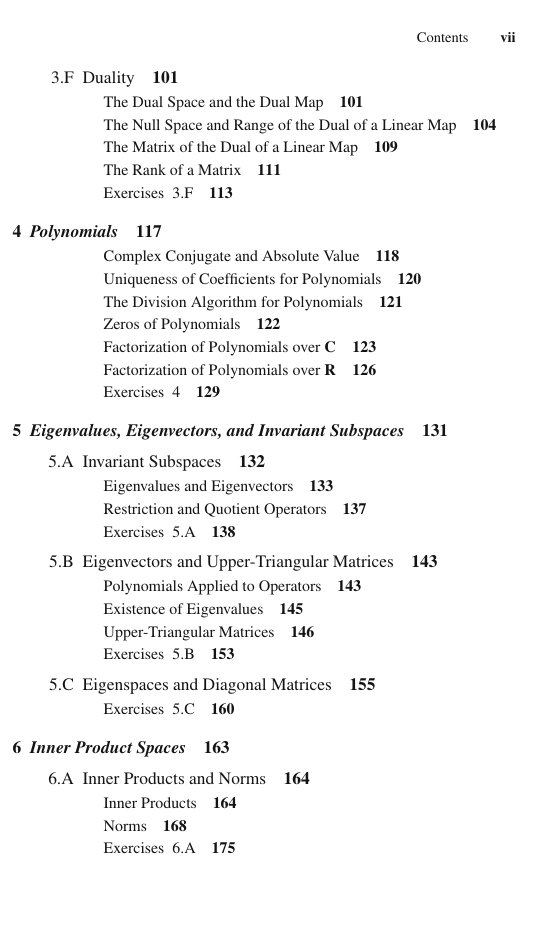Contents
Preface for the Instructor
Preface for the Student
Acknowledgments
CHAPTER 1
Vector Spaces
1.A Rn and Cn
Complex Numbers
1.1 Definition
1.2 Example
1.3 Properties of complex arithmetic
1.4 Example
1.5 Definition
1.6 Notation
Lists
1.7 Example
1.8 Definition
1.9 Example
1.10 Definition
1.11 Example
1.12 Definition
1.13 Commutativity of addition in Fn
1.14 Definition
1.15 Example
1.16 Definition
1.17 Definition
Digression on Fields
EXERCISES 1.A
1.B Definition of Vector Space
1.18 Definition
1.19 Definition
1.20 Definition
1.21 Definition
1.22 Example
1.23 Notation
1.24 Example
1.25 Unique additive identity
1.26 Unique additive inverse
1.27 Notation
1.28 Notation
1.29 The number 0 times a vector
1.30 A number times the vector 0
1.31 The number �1 times a vector
EXERCISES 1.B
1.C Subspaces
1.32 Definition
1.33 Example
1.34 Conditions for a subspace
1.35 Example
Sums of Subspaces
1.36 Definition
1.37 Example
1.38 Example
1.39 Sum of subspaces is the smallest containing subspace
Direct Sums
1.40 Definition
1.41 Example
1.42 Example
1.43 Example
1.44 Condition for a direct sum
1.45 Direct sum of two subspaces
EXERCISES 1.C
CHAPTER 2
Finite-Dimensional Vector Spaces
2.1 Notation
2.A Span and Linear Independence
Linear Combinations and Span
2.2 Notation
2.3 Definition
2.4 Example
2.5 Definition
2.6 Example
2.7 Span is the smallest containing subspace
2.8 Definition
2.9 Example
2.10 Definition
2.11 Definition
2.12 Definition
2.13 Definition
2.14 Example
2.15 Definition
2.16 Example
Linear Independence
2.17 Definition
2.18 Example
2.20 Example
2.21 Linear Dependence Lemma
2.22
2.23 Length of linearly independent list ≤ length of spanning list
2.24 Example
2.25 Example
2.26 Finite-dimensional subspaces
EXERCISES 2.A
2.B Bases
2.27 Definition
2.28 Example
2.29 Criterion for basis
2.30
2.31 Spanning list contains a basis
2.32 Basis of finite-dimensional vector space
2.33 Linearly independent list extends to a basis
2.34 Every subspace of V is part of a direct sum equal to V
EXERCISES 2.B
2.C Dimension
2.35 Basis length does not depend on basis
2.36 Definition
2.37 Example
2.38 Dimension of a subspace
2.39 Linearly independent list of the right length is a basis
2.40 Example
2.41 Example
2.42 Spanning list of the right length is a basis
2.43 Dimension of a sum
EXERCISES 2.C
CHAPTER 3
Linear Maps
3.1 Notation
3.A The Vector Space of Linear Maps
Definition and Examples of Linear Maps
3.2 Definition
3.3 Notation
3.4 Example
3.5 Linear maps and basis of domain
Algebraic Operations on L(V,W)
3.7 L(V,W) is a vector space
3.8 Definition
3.9 Algebraic properties of products of linear maps
3.10 Example
3.11 Linear maps take 0 to 0
EXERCISES 3.A
3.B Null Spaces and Ranges
Null Space and Injectivity
3.12 Definition
3.13 Example
3.14 The null space is a subspace
3.15 Definition
3.16 Injectivity is equivalent to null space equals {0}
Range and Surjectivity
3.17 Definition
3.18 Example
3.19 The range is a subspace
3.20 Definition
3.21 Example
Fundamental Theorem of Linear Maps
3.22 Fundamental Theorem of Linear Maps
3.23 A map to a smaller dimensional space is not injective
3.24 A map to a larger dimensional space is not surjective
3.25 Example
3.26 Homogeneous system of linear equations
3.27 Example
3.28
3.29 Inhomogeneous system of linear equations
EXERCISES 3.B
3.C Matrices
Representing a Linear Map by a Matrix
3.30 Definition
3.31 Example
3.32 Definition
3.33 Example
3.34 Example
Addition and Scalar Multiplication of Matrices
3.35 Definition
3.36 The matrix of the sum of linear maps
3.37 Definition
3.38 The matrix of a scalar times a linear map
3.39 Notation
3.40 dim Fm,n = mn
Matrix Multiplication
3.41 Definition
3.42 Example
3.43 The matrix of the product of linear maps
3.44 Notation
3.45 Example
3.46 Example
3.48 Example
3.49 Column of matrix product equals matrix times column
3.50 Example
3.51 Example
3.52 Linear combination of columns
EXERCISES 3.C
3.D Invertibility and Isomorphic Vector Spaces
Invertible Linear Maps
3.53 Definition
3.54 Inverse is unique
3.55 Notation
3.56 Invertibility is equivalent to injectivity and surjectivity
3.57 Example
Isomorphic Vector Spaces
3.58 Definition
3.59 Dimension shows whether vector spaces are isomorphic
3.60 L(V;W) and Fm,n are isomorphic
3.61 dimL(V;W) = (dimV)(dimW)
Linear Maps Thought of as Matrix Multiplication
3.62 Definition
3.63 Example
3.64 M(T ).,k = M(vk).
3.65 Linear maps act like matrix multiplication
3.66
Operators
3.67 Definition
3.68 Example
3.69 Injectivity is equivalent to surjectivity in finite dimensions
3.70 Example
EXERCISES 3.D
3.E Products and Quotients of Vector Spaces
Products of Vector Spaces
3.71 Definition
3.72 Example
3.73 Product of vector spaces is a vector space
3.74 Example
3.75 Example
3.76 Dimension of a product is the sum of dimensions
Products and Direct Sums
3.77 Products and direct sums
3.78 A sum is a direct sum if and only if dimensions add up
Quotients of Vector Spaces
3.79 Definition
3.80 Example
3.81 Definition
3.82 Example
3.83 Definition
3.84 Example
3.85 Two affine subsets parallel to U are equal or disjoint
3.86 Definition
3.87 Quotient space is a vector space
3.88 Definition
3.89 Dimension of a quotient space
3.90 Definition
3.91 Null space and range of T
EXERCISES 3.E
3.F Duality
The Dual Space and the Dual Map
3.92 Definition
3.93 Example
3.94 Definition
3.95 dim V' = dim V
3.96 Definition
3.97 Example
3.98 Dual basis is a basis of the dual space
3.99 Definition
3.100 Example
3.101 Algebraic properties of dual maps
The Null Space and Range of the Dual of a Linear Map
3.102 Definition
3.103 Example
3.104 Example
3.105 The annihilator is a subspace
3.106 Dimension of the annihilator
3.107 The null space of T'
3.108 T' surjective is equivalent to T' injective
3.109 The range of T'
3.110 T' injective is equivalent to T' surjective
The Matrix of the Dual of a Linear Map
3.111 Definition
3.112 Example
3.113 The transpose of the product of matrices
3.114 The matrix of T' is the transpose of the matrix of T'
The Rank of a Matrix
3.115 Definition
3.116 Example
3.117 Dimension of range T equals column rank of M(T)
3.118 Row rank equals column rank
3.119 Definition
EXERCISES 3.F
CHAPTER 4
Polynomials
4.1 Notation
Complex Conjugate and Absolute Value
4.2 Definition
4.3 Definition
4.4 Example
4.5 Properties of complex numbers
Uniqueness of Coefficients for Polynomials
4.6
4.7 If a polynomial is the zero function, then all coefficients are 0
The Division Algorithm for Polynomials
4.8 Division Algorithm for Polynomials
Zeros of Polynomials
4.9 Definition
4.10 Definition
4.11 Each zero of a polynomial corresponds to a degree-1 factor
4.12 A polynomial has at most as many zeros as its degree
Factorization of polynomials over C
4.13 Fundamental Theorem of Algebra
4.14 Factorization of a polynomial over C
Factorization of polynomials over R
4.15 Polynomials with real coefficients have zeros in pairs
4.16 Factorization of a quadratic polynomial
4.17 Factorization of a polynomial over R
EXERCISES 4
CHAPTER 5
Eigenvalues, Eigenvectors, and Invariant Subspaces
5.1 Notation
5.A Invariant Subspaces
5.2 Definition
5.3 Example
5.4 Example
Eigenvalues and Eigenvectors
5.5 Definition
5.6 Equivalent conditions to be an eigenvalue
5.7 Definition
5.8 Example
5.9
5.10 Linearly independent eigenvectors
5.11
5.12
5.13 Number of eigenvalues
Restriction and Quotient Operators
5.14 Definition
5.15 Example
EXERCISES 5.A
5.B Eigenvectors and Upper-Triangular Matrices
Polynomials Applied to Operators
5.16 Definition
5.17 Definition
5.18 Example
5.19 Definition
5.20 Multiplicative properties
Existence of Eigenvalues
5.21 Operators on complex vector spaces have an eigenvalue
Upper-Triangular Matrices
5.22 Definition
5.23 Example
5.24 Definition
5.25 Definition
5.26 Conditions for upper-triangular matrix
5.27 Over C, every operator has an upper-triangular matrix
5.28
5.29
5.30 Determination of invertibility from upper-triangular matrix
5.31
5.32 Determination of eigenvalues from upper-triangular matrix
5.33 Example
EXERCISES 5.B
5.C Eigenspaces and Diagonal Matrices
5.34 Definition
5.35 Example
5.36 Definition
5.37 Example
5.38 Sum of eigenspaces is a direct sum
5.39 Definition
5.40 Example
5.41 Conditions equivalent to diagonalizability
5.42
5.43 Example
5.44 Enough eigenvalues implies diagonalizability
5.45 Example
EXERCISES 5.C
CHAPTER 6
Inner Product Spaces
6.1 Notation
6.A Inner Products and Norms
Inner Products
6.2 Definition
6.3 Definition
6.4 Example
6.5 Definition
6.6 Notation
6.7 Basic properties of an inner product
Norms
6.8 Definition
6.9 Example
6.10 Basic properties of the norm
6.11 Definition
6.12 Orthogonality and 0
6.13 Pythagorean Theorem
6.14 An orthogonal decomposition
6.15 Cauchy–Schwarz Inequality
6.16
6.17 Example
6.18 Triangle Inequality
6.19
6.20
6.21
6.22 Parallelogram Equality
EXERCISES 6.A
6.B Orthonormal Bases
6.23 Definition
6.24 Example
6.25 The norm of an orthonormal linear combination
6.26 An orthonormal list is linearly independent
6.27 Definition
6.28 An orthonormal list of the right length is an orthonormal basis
6.29 Example
6.30 Writing a vector as linear combination of orthonormal basis
6.31 Gram–Schmidt Procedure
6.32
6.33 Example
6.34 Existence of orthonormal basis
6.35 Orthonormal list extends to orthonormal basis
6.37 Upper-triangular matrix with respect to orthonormal basis
6.38 Schur’s Theorem
Linear Functionals on Inner Product Spaces
6.39 Definition
6.40 Example
6.41 Example
6.42 Riesz Representation Theorem
6.43
6.44 Example
EXERCISES 6.B
6.C Orthogonal Complements and Minimization Problems
Orthogonal Complements
6.45 Definition
6.46 Basic properties of orthogonal complement
6.47 Direct sum of a subspace and its orthogonal complement
6.48
6.49
6.50 Dimension of the orthogonal complement
6.51 The orthogonal complement of the orthogonal complement
6.52
6.53 Definition
6.54 Example
6.55 Properties of the orthogonal projection PU
Minimization Problems
6.56 Minimizing the distance to a subspace
6.57
6.58 Example
6.59
6.60
6.61
EXERCISES 6.C
CHAPTER 7
Operators on Inner Product Spaces
7.1 Notation
7.A Self-Adjoint and Normal Operators
Adjoints
7.2 Definition
7.3 Example
7.4 Example
7.5 The adjoint is a linear map
7.6 Properties of the adjoint
7.7 Null space and range of T*
7.8 Definition
7.9 Example
7.10 The matrix of T*
Self-Adjoint Operators
7.11 Definition
7.12 Example
7.13 Eigenvalues of self-adjoint operators are real
7.14 Over C, T v is orthogonal to v for all v only for the 0 operator
7.15 Over C, (Tv, v) is real for all v only for self-adjoint operators
7.16 If T = T* and (Tv, v) = 0 for all v, then T = 0
7.17
Normal Operators
7.18 Definition
7.19 Example
7.20 T is normal if and only if |T v| = ||T v|| for all v
7.21 For T normal, T and T* have the same eigenvectors
7.22 Orthogonal eigenvectors for normal operators
EXERCISES 7.A
7.B The Spectral Theorem
The Complex Spectral Theorem
7.23 Example
7.24 Complex Spectral Theorem
7.25
The Real Spectral Theorem
7.26 Invertible quadratic expressions
7.27 Self-adjoint operators have eigenvalues
7.28 Self-adjoint operators and invariant subspaces
7.29 Real Spectral Theorem
7.30 Example
EXERCISES 7.B
7.C Positive Operators and Isometries
Positive Operators
7.31 Definition
7.32 Example
7.33 Definition
7.34 Example
7.35 Characterization of positive operators
7.36 Each positive operator has only one positive square root
Isometries
7.37 Definition
7.38 Example
7.39
7.40
7.41
7.42 Characterization of isometries
7.43 Description of isometries when F = C
EXERCISES 7.C
7.D Polar Decomposition and Singular Value Decomposition
Polar Decomposition
7.44 Notation
7.45 Polar Decomposition
7.46
7.47
7.48
Singular Value Decomposition
7.49 Definition
7.50 Example
7.51 Singular Value Decomposition
EXERCISES 7.D
CHAPTER 8
Operators on Complex Vector Spaces
8.1 Notation
8.A Generalized Eigenvectors and Nilpotent Operators
Null Spaces of Powers of an Operator
8.2 Sequence of increasing null spaces
8.3 Equality in the sequence of null spaces
8.4 Null spaces stop growing
8.5 V is the direct sum of null T dimV and range TdimV
8.6
8.7 Example
Generalized Eigenvectors
8.8
8.9 Definition
8.10 Definition
8.11 Description of generalized eigenspaces
8.12 Example
8.13 Linearly independent generalized eigenvectors
8.14
8.15
Nilpotent Operators
8.16 Definition
8.17 Example
8.18 Nilpotent operator raised to dimension of domain is 0
8.19 Matrix of a nilpotent operator
EXERCISES 8.A
8.B Decomposition of an Operator
Description of Operators on Complex Vector Spaces
8.20 The null space and range of p(T) are invariant under T
8.21 Description of operators on complex vector spaces
8.22
8.23 A basis of generalized eigenvectors
Multiplicity of an Eigenvalue
8.24 Definition
8.25 Example
8.26 Sum of the multiplicities equals dim V
Block Diagonal Matrices
8.27 Definition
8.28 Example
8.29 Block diagonal matrix with upper-triangular blocks
8.30 Example
Square Roots
8.31 Identity plus nilpotent has a square root
8.32
8.33 Over C, invertible operators have square roots
EXERCISES 8.B
8.C Characteristic and Minimal Polynomials
The Cayley–Hamilton Theorem
8.34 Definition
8.35 Example
8.36 Degree and zeros of characteristic polynomial
8.37 Cayley–Hamilton Theorem
The Minimal Polynomial
8.38 Definition
8.39 Example
8.40 Minimal polynomial
8.41
8.42
8.43 Definition
8.44
8.45 Example
8.46 q(T) = 0 implies q is a multiple of the minimal polynomial
8.47
8.48 Characteristic polynomial is a multiple of minimal polynomial
8.49 Eigenvalues are the zeros of the minimal polynomial
8.50 Example
8.51 Example
8.52 Example
EXERCISES 8.C
8.D Jordan Form
8.53 Example
8.54 Example
8.55 Basis corresponding to a nilpotent operator
8.56
8.57
8.58
8.59 Definition
8.60 Jordan Form
EXERCISES 8.D
CHAPTER 9
Operators on Real Vector Spaces
9.1 Notation
9.A Complexification
Complexification of a Vector Space
9.2 Definition
9.3 VC is a complex vector space.
9.4 Basis of V is basis of VC
Complexification of an Operator
9.5 Definition
9.6 Example
9.7 Matrix of TC equals matrix of T
9.8 Every operator has an invariant subspace of dimension 1 or 2
The Minimal Polynomial of the Complexification
9.9
9.10 Minimal polynomial of TC equals minimal polynomial of T
Eigenvalues of the Complexification
9.11 Real eigenvalues of TC
9.12 TC –λI and TC – λI
9.13
9.14
9.15
9.16 Nonreal eigenvalues of TC come in pairs
9.17 Multiplicity of λ equals multiplicity of λ
9.18 Example
9.19 Operator on odd-dimensional vector space has eigenvalue
Characteristic Polynomial of the Complexification
9.20 Characteristic polynomial of TC
9.21 Definition
9.22 Example
9.23 Degree and zeros of characteristic polynomial
9.24 Cayley–Hamilton Theorem
9.25 Example
9.26 Characteristic polynomial is a multiple of minimal polynomial
EXERCISES 9.A
9.B Operators on Real Inner Product Spaces
Normal Operators on Real Inner Product Spaces
9.27 Normal but not self-adjoint operators
9.28
9.29
9.30 Normal operators and invariant subspaces
9.31
9.32
9.33
9.34 Characterization of normal operators when F = R
Isometries on Real Inner Product Spaces
9.35 Example
9.36 Description of isometries when F D R
9.37
EXERCISES 9.B
CHAPTER 10
Trace and Determinant
10.1 Notation
10.A Trace
Change of Basis
10.2 Definition
10.3 Definition
10.4 The matrix of the product of linear maps
10.5 Matrix of the identity with respect to two bases
10.6 Example
10.7 Change of basis formula
10.8
Trace: A Connection Between Operators and Matrices
10.9 Definition
10.10 Example
10.11
10.12 Trace and characteristic polynomial
10.13 Definition
10.14 Trace of AB equals trace of BA
10.15 Trace of matrix of operator does not depend on basis
10.16 Trace of an operator equals trace of its matrix
10.17 Example
10.18 Trace is additive
10.19 The identity is not the difference of ST and TS
EXERCISES 10.A
10.B Determinant
Determinant of an Operator
10.20 Definition
10.21 Example
10.22 Determinant and characteristic polynomial
10.23 Characteristic polynomial, trace, and determinant
10.24 Invertible is equivalent to nonzero determinant
10.25 Characteristic polynomial of T equals det(zI – T)
Determinant of a Matrix
10.26 Example
10.27 Definition
10.28 Example
10.29
10.30 Definition
10.31 Example
10.32 Interchanging two entries in a permutation
10.33 Definition
10.34 Example
10.35 Example
10.36 Interchanging two columns in a matrix
10.37 Matrices with two equal columns
10.38 Permuting the columns of a matrix
10.39 Determinant is a linear function of each column
10.40 Determinant is multiplicative
10.41 Determinant of matrix of operator does not depend on basis
10.42 Determinant of an operator equals determinant of its matrix
10.43 Example
10.44 Determinant is multiplicative
The Sign of the Determinant
10.45 Isometries have determinant with absolute value 1
10.46 Example
Volume
10.48 Definition
10.49 Definition
10.50 Definition
10.51 Notation
10.52 Positive operators change volume by factor of determinant
10.53 An isometry does not change volume
10.54 T changes volume by factor of |det T|
10.55 Definition
10.56 Definition
10.57
10.58 Change of variables in an integral
10.59 Example
10.60 Example
EXERCISES 10.B
Photo Credits
Symbol Index
Index
















 2023年江西萍乡中考道德与法治真题及答案.doc
2023年江西萍乡中考道德与法治真题及答案.doc 2012年重庆南川中考生物真题及答案.doc
2012年重庆南川中考生物真题及答案.doc 2013年江西师范大学地理学综合及文艺理论基础考研真题.doc
2013年江西师范大学地理学综合及文艺理论基础考研真题.doc 2020年四川甘孜小升初语文真题及答案I卷.doc
2020年四川甘孜小升初语文真题及答案I卷.doc 2020年注册岩土工程师专业基础考试真题及答案.doc
2020年注册岩土工程师专业基础考试真题及答案.doc 2023-2024学年福建省厦门市九年级上学期数学月考试题及答案.doc
2023-2024学年福建省厦门市九年级上学期数学月考试题及答案.doc 2021-2022学年辽宁省沈阳市大东区九年级上学期语文期末试题及答案.doc
2021-2022学年辽宁省沈阳市大东区九年级上学期语文期末试题及答案.doc 2022-2023学年北京东城区初三第一学期物理期末试卷及答案.doc
2022-2023学年北京东城区初三第一学期物理期末试卷及答案.doc 2018上半年江西教师资格初中地理学科知识与教学能力真题及答案.doc
2018上半年江西教师资格初中地理学科知识与教学能力真题及答案.doc 2012年河北国家公务员申论考试真题及答案-省级.doc
2012年河北国家公务员申论考试真题及答案-省级.doc 2020-2021学年江苏省扬州市江都区邵樊片九年级上学期数学第一次质量检测试题及答案.doc
2020-2021学年江苏省扬州市江都区邵樊片九年级上学期数学第一次质量检测试题及答案.doc 2022下半年黑龙江教师资格证中学综合素质真题及答案.doc
2022下半年黑龙江教师资格证中学综合素质真题及答案.doc